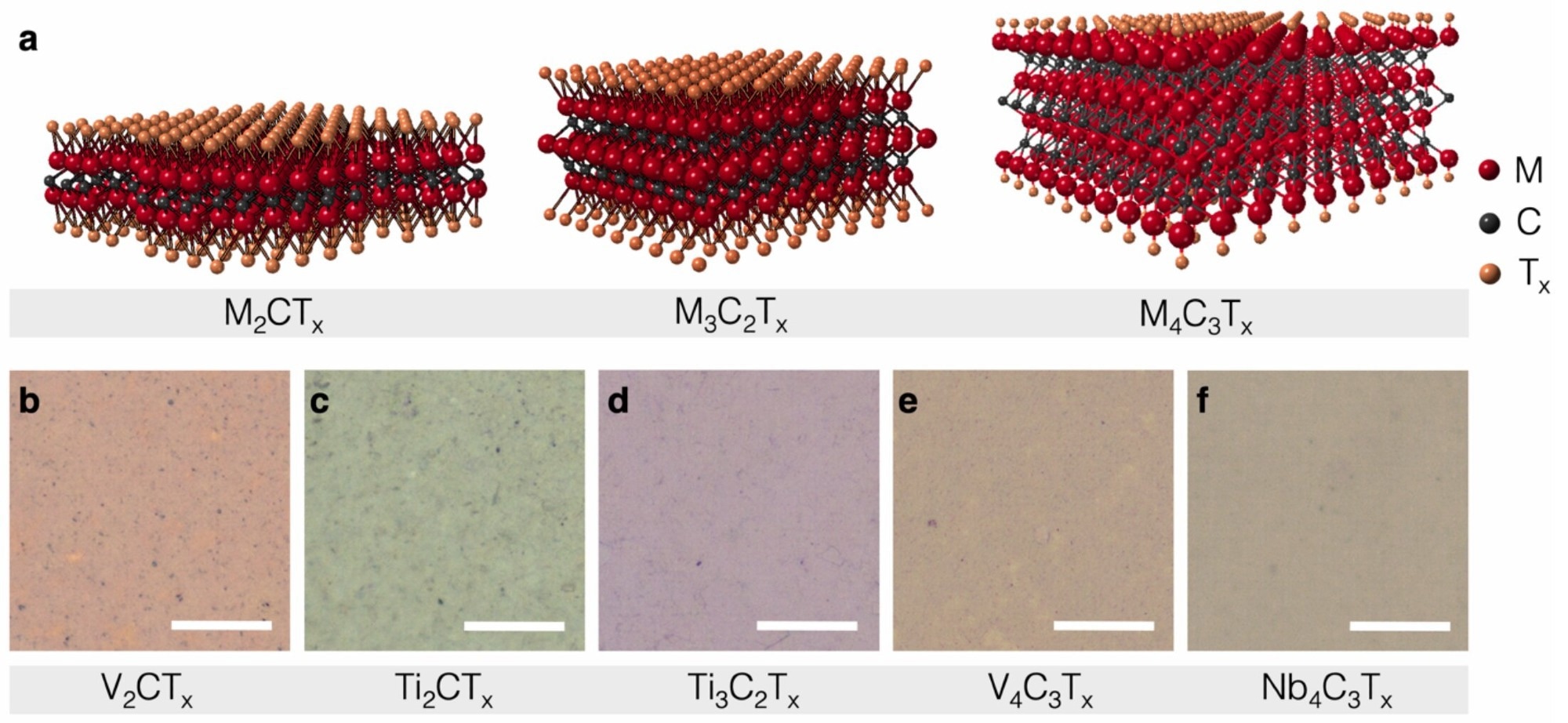Drexel University’s College of Engineering researchers have created a thin film device that can block electromagnetic radiation with the flick of a switch. The innovation, made possible by two-dimensional materials known as MXenes, has the potential to improve the performance of electronic devices, enhance wireless connections, and secure mobile communications from intrusion.

MXene electrodes used in this work. a, Schematics of MXene with different numbers of atomic layers. Optical images of (b) V2CTx, (c) Ti2CTx, (d) Ti3C2Tx, (e) V4C3Tx, and (f) Nb4C3Tx. Scale bar, 20 μm. Credit: Nature Nanotechnology (2023). DOI: 10.1038/s41565-022-01308-9
The group, guided by Yury Gogotsi, Ph.D., Distinguished University and Bach Professor in Drexel’s College of Engineering, demonstrated previously that the two-dimensional layered MXene materials, explored just over a decade ago, can be transformed into a potent active shield against electromagnetic waves when integrated with an electrolyte solution.
This latest MXene finding, published in Nature Nanotechnology, demonstrates how this shielding may be tweaked by applying a low voltage—less than that produced by an alkaline battery.
Dynamic control of electromagnetic wave jamming has been a significant technological challenge for protecting electronic devices working at gigahertz frequencies and a variety of other communications technologies.
Yury Gogotsi, Distinguished University and Bach Professor, College of Engineering, Drexel University
Yury Gogotsi adds, “As the number of wireless devices being used in industrial and private sectors has increased by orders of magnitude over the past decade, the urgency of this challenge has grown accordingly. This is why our discovery—which would dynamically mitigate the effect of electromagnetic interference on these devices – could have a broad impact.”
MXene is a one-of-a-kind material in that it is highly conductive, making it ideal for reflecting microwave radiation that might induce static, feedback, or deteriorate communications device performance. However, its internal chemical structure can also be temporarily changed to enable these electromagnetic waves to pass through.
This implies that a thin coating on a gadget or electrical component protects it from both emitting and being penetrated by electromagnetic waves emitted by other electronics. While eliminating the likelihood of interference from both internal and external sources can improve device performance, some waves must be permitted to exit and enter when the device is used for communication.
Without being able to control the ebb and flow of electromagnetic waves within and around a device, it’s a bit like a leaky faucet – you’re not really turning off the water and that constant dripping is no good. Our shielding ensures the plumbing is tight—so-to-speak—no electromagnetic radiation is leaking out or getting in until we want to use the device.
Yury Gogotsi, Distinguished University and Bach Professor, College of Engineering, Drexel University
The key to achieving bidirectional tunability of MXene shielding properties is to use ion flow and expulsion to alternately expand and compress the gap between material layers, similar to an accordion, and alter the surface chemistry of MXenes.
When a low voltage is applied to the film, ions enter—or intercalate—between the MXene layers, changing the charge on their surface and producing electrostatic attraction, which changes the layer spacing, conductivity, and shielding efficacy of the material. The MXene layers recover to their former condition when the ions are deintercalated and the current is turned off.
The researchers experimented with ten distinct MXene-electrolyte combinations, spraying each with a paint sprayer in a layer 30 to 100 times thinner than a human hair. The materials repeatedly displayed dynamic tunability of shielding efficacy in obstructing microwave radiation, which conventional metals such as copper and steel cannot do. And the device’s performance was maintained after more than 500 charge-discharge cycles.
Gogotsi and his Co-Authors note, “These results indicate that the MXene films can convert from electromagnetic interference shielding to quasi-electromagnetic wave transmission by electrochemical oxidation of MXenes. The MXene film can potentially serve as a dynamic EMI shielding switch.”
Gogotsi proposes that the MXene shielding could conceal devices from detection by radar or other tracing methods in security applications. The researchers also investigated the feasibility of a one-way shielding switch. This would facilitate a device to remain invisible and safe from unauthorized access until it is ready to use.
A one-way switch could open the protection and allow a signal to be sent or communication to be opened in an emergency or at the required moment. This means it could protect communications equipment from being influenced or tampered with until it is in use. For example, it could encase the device during transportation or storage and then activate only when it is ready to be used.
Yury Gogotsi, Distinguished University and Bach Professor, College of Engineering, Drexel University
Gogotsi’s team intends to investigate different MXene-electrolyte combinations and techniques to fine-tune the shielding to obtain a better modulation of electromagnetic wave transmission and dynamic modification to block radiation at a multitude of bandwidths.
Journal Reference:
Han, M., et al. (2023) Electrochemically modulated interaction of MXenes with microwaves. Nature Nanotechnology. doi.org/10.1038/s41565-022-01308-9.